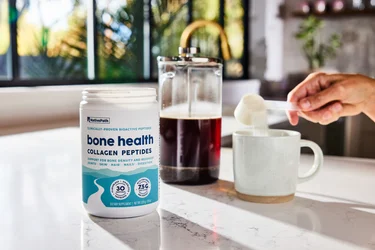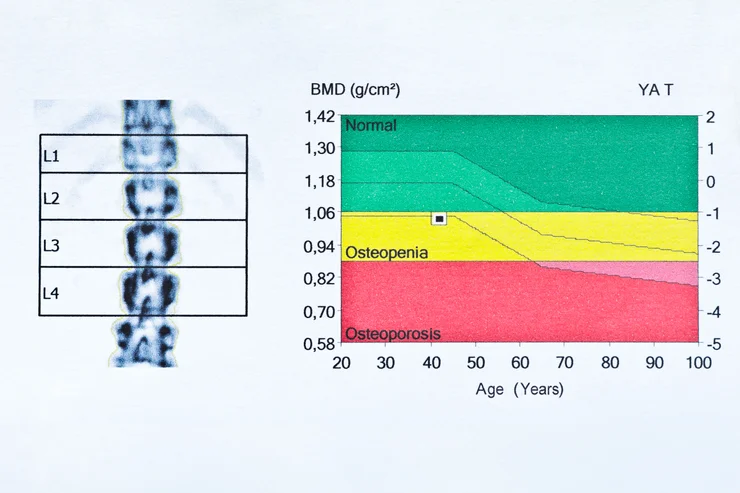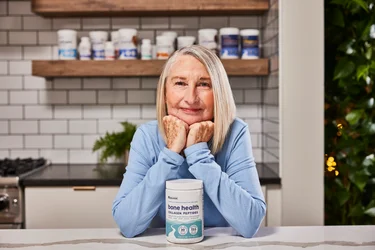Health
Osteopenia: What It Is, How to Prevent It, and the Best (Natural) Remedy
Updated on January 18, 2024
You received your bone density test scores back and now your doctor is saying that you have something called osteopenia.
Now you—along with 47 million other Americans—have this condition, and the first few thoughts that come to your mind are: What in the world is osteopenia? How is it different from osteoporosis? And most importantly—Is it reversible?
Read on to get your most pressing questions answered...
What Is Osteopenia?
‘Osteo’ means “related to bones” and ‘penia’ means “to lack or have a deficiency” (1).
Thus, osteopenia (like osteoporosis) is a condition related to bone loss. This bone loss is measured by bone mineral density, which shows the strength and thickness of your bones (and more importantly: whether or not they’re at risk of future fractures) (2).
To understand the difference between osteopenia and osteoporosis, think of bone mineral density as a slope—with the top being normal (healthy bones) and the bottom being osteoporosis (unhealthy bones). Osteopenia, which affects nearly half of Americans over the age of 50, falls somewhere in between (2, 3).
How to Measure Bone Mineral Density
Bone mineral density is measured by getting a DEXA scan—a dual-energy X-ray absorptiometry. It’s an inexpensive, noninvasive, 10-20 minute test that helps diagnose bone-related health conditions.
DEXA was approved by the Food and Drug Administration (FDA) in 1988 and is one of the safer options in terms of bone density tests. It has relatively low radiation (it can be comparable to standard background radiation).
If you’re pregnant, it is strongly recommended to not get a DEXA scan. Although chances for cancer are extremely low (like 0.3 in a million), they are not zero. In most cases, a pregnancy test may be needed in order for the DEXA scan to be administered (4, 5).

Improve Your DEXA Score with Bone Health Collagen
NativePath Bone Health contains FORTIBONE® and VERISOL®—two proprietary and clinically-proven Bioactive Collagen Peptides that promote strong bones plus healthy skin, hair, and nails.
How to Understand Your Bone Density Score
A licensed radiologist will review your scans and determine your T Score—a measurement that compares your bone density measurement to that of a healthy 30-year-old (this is the age when peak bone mass occurs). The higher the T Score, the better. A low T Score signifies bone loss (4).

What Your DEXA Score Means
Upon receiving your DEXA scan results, you’ll be given a T Score. Use the following chart to understand what it means.
- Normal: Greater than or equal to -1.0
- Osteopenia: -1.0 to -2.5
- Osteoporosis: Less than or equal to -2.5
- Severe Osteoporosis: Less than or equal to -2.5 (plus fragility fracture)
The Major Cause of Osteopenia
The major cause of osteopenia can be boiled down to one thing: aging.
Once your bone mass peaks (at around age 30), your body breaks down old bone faster than it creates new bone. Which means you lose more and more bone density with each passing year. In addition to that, women are more susceptible to lower bone density due to menopause and the lowering of estrogen (6).
Here’s the breakdown (7):
- Ages 40-45: 0.3–0.5% per year
- Ages 45-55 (i.e. the perimenopausal period): 4–6% per year
- Age 70: 1–2% per year
Thus, age is the strongest predictor of fracture risk.
Other Factors That Put You at Risk of Osteopenia
1. Major Modifiable Risk Factors:
- Inadequate nutritional absorption
- Lack of physical activity (resistance exercise, in particular)
- Having a very low body weight
- Smoking cigarettes
- Heavy alcohol consumption
- Air pollution
- Stress
- Low sunlight exposure
2. Major Non-Modifiable Risk Factors:
- History of falls
- Older age
- Gender
- White ethnic background
- Prior fracture
- Loss of height
- Family history of bone loss or fracture
3. Secondary Causes of Osteopenia
- Chronic use of certain medications (such as corticosteroids)
- Hypogonadism
- Hyperparathyroidism
- Chronic liver disease
- Inflammatory diseases (rheumatoid arthritis)
- Estrogen deficiency
- Lack of calcium, vitamin D, and/or collagen
- Renal disease or history of kidney stones
- Cardiovascular disease
- Diabetes mellitus
- Dementia
Symptoms of Osteopenia
Surprisingly, osteopenia usually goes undetected until a fracture occurs.
However, symptoms may include:
- Severe pain in your back, hips, and joints
- Stooped posture
- Loss of height
The Best (Natural) Treatment for Osteopenia
Believe it or not, osteopenia can be reversible.
Bones are constantly turning over throughout one’s life. Osteopenia and osteoporosis simply arise when bone turnover slows. Thus, what your bones need is support.
A simple way to get that support, you ask?
Collagen is the most abundant protein in your body—making up 33% of it, in fact. However, once you hit about 25 years of age, collagen production begins to slow—declining by 1% with each passing year (8, 9).
This means that by the age of 50, your collagen levels have been slashed in half. One of the tell-tale signs of low collagen levels is joint pain, back pain, and/or weak bones.
When you take a collagen supplement daily, you’re equipping your body (and bones) with what it needs to restore that bone loss.
Native Tip: For more bone-building tips, read this article next: 12 Tips to Strengthen Your Bones (None of Them Are Dairy)

Better Bone Health In Every Scoop
NativePath Bone Health contains FORTIBONE® and VERISOL®—two proprietary and clinically-proven Bioactive Collagen Peptides that promote strong bones plus healthy skin, hair, and nails.
3 Additional Ways to Prevent Further Bone Loss Include:
- Doing more weight-bearing exercises like walking, dancing, or using weight machines.
- Adding calcium and vitamin D to your diet.
- Maintaining a healthy diet. Check out the top 5 bone-dissolving foods here.
Frequently Asked Questions ABout Osteoporosis
If you’re a female over the age of 65, a male over 70, or have had a hip fracture, a bone mineral density (BMD) test is highly recommended (4).
The Bottom Line
Staying on top of bone health is vital. Especially if you’re a female over the age of 65, or have had a hip fracture before the age of 50.
Osteopenia—a condition related to bone loss—is reversible with the right diet, supplements, resistance exercise, and care plan.
Something you can do today is invest in a high-quality collagen supplement. This will give your bones what they need to regain strength and density. Take Marsha and Pauline, for example…
Marsha states, “I am 71 years old and have been diagnosed with osteopenia that requires treatment..I have noticed an increase and solidity in some of my muscles..Only time and a dexascan in the future will tell me if my osteopenia has improved.”
And after only 6 weeks, Pauline says her “bones are not as achy.”
I’m not saying that collagen is the end-all, cure-all, but it will definitely help alleviate symptoms while increasing bone density. Like Marsha said...only time will tell!
If you have questions about your results and/or treatments for bone loss, talk to a healthcare professional.
Caroline Nicks
Caroline Nicks
NativePath has strict sourcing guidelines and relies on peer-reviewed studies, academic research institutions, and medical associations. We avoid using tertiary references.
Medical Disclaimer
This content is for informational and educational purposes only. It is not intended to provide medical advice or to take the place of such advice or treatment from a personal physician. All readers/viewers of this content are advised to consult their doctors or qualified health professionals regarding specific health questions. Neither Dr. Chad Walding nor the publisher of this content takes responsibility for possible health consequences of any person or persons reading or following the information in this educational content. All viewers of this content, especially those taking prescription or over-the-counter medications, should consult their physicians before beginning any nutrition, supplement, or lifestyle program.


